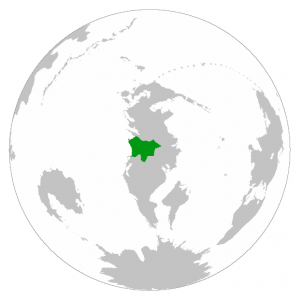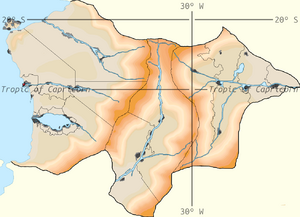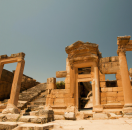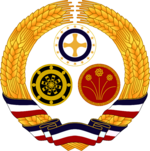UPRAN (Pacifica): Difference between revisions
No edit summary Tag: 2017 source edit |
No edit summary Tag: 2017 source edit |
||
| Line 70: | Line 70: | ||
|established_event8= Moneli dynasty | |established_event8= Moneli dynasty | ||
|established_date8 = 812 AD-1347 AD | |established_date8 = 812 AD-1347 AD | ||
|established_event9 = | |established_event9= Echemmon dynasty | ||
|established_date9 = | |established_date9 = 1347-1588 | ||
| | |established_event10= Akadios dynasty | ||
| | |established_date10 = 1588-1736 | ||
|established_event11= Calypso dynasty | |||
|established_date11 = 1736-1789 | |||
|established_event12= Hyrmina dynasty | |||
|established_date12 = 2 July, 1789-1871 | |||
|established_event13= The Eminent Thirteen's Regency | |||
|established_date13 = 18 December, 1871-1884 | |||
|established_event14= Aglaia dynasty | |||
|established_date14 = 4 December, 1884-1907 | |||
|established_event16= The Ternary Republics | |||
|established_date16 = 12 June, 1907-1923 | |||
|established_event17= The Gennaíos | |||
|established_date17 = 13 April, 1923-1953 | |||
|established_event18= The Endiámeso | |||
|established_date18 = 13 December, 1953-1965 | |||
|established_event19= UPRAN Republic | |||
|established_date19 = 6 May, 1965-2021 | |||
|area_km2 = 931,948 | |area_km2 = 931,948 | ||
Revision as of 19:00, 27 December 2022
United Provinces of Rhayna, Alla-gy and Néa-gy Ηνωμένες Επαρχίες του Ράινα, Αλλα-Γη και Νέα-Γη | |
|---|---|
Motto: Long Life Us All Mάκρος ζωή Μας Ολοι | |
Anthem: Monopáti gia Ólous Μονοπάτι για Óλους | |
 Location of Rhayna in the South Pacific | |
 Closeup of Rhayna | |
| Capital | Pzárya |
| Largest city | Rouketá |
| Official languages | Aegean |
| Recognised national languages | Aegean |
| Sign languages | Aegean Sign Language Νοηματική Γλώσσα Αιγαίο (ΝΓA/NGA) |
| Ethnic groups (2022 census) | 18.67% Rhaynans 7.82% Alla-gyans 73.43% Néa-gyans 0.08% Romordians |
| Religion (2022 census) | 49.0% Religious 49.1% No religion 1.9% Unanswered |
| Demonym(s) | Rhaynan |
| Government | Federal democratic presidential constitutional republic |
• Prytanis of Rhayna | Boutros Georgiou |
• Viceprytanis of Rhayna | Gisella de Luca |
• Prytanis of Rhayna's Chamber of Deputies | Aria Iliadis |
• Archigós of the Konkrésou | Fabiano Marchesi |
• Archigós of Justice | Markos Christellis |
| Legislature | Genikés Kámeres |
| The Konkrésou | |
| The Rhaynan Voulí | |
| Federal independent republic | |
• Unification of most Rhaynan city states | 1100 BC |
• Galaniades dynasty | 1100 BC-894 BC |
• Strateas dynasty | 894 BC-387 BC |
• Loreas dynasty | 387 BC-35 AD |
• Lagatos dynasty | 35 AD-224 AD |
• Zerveas dynasty | 224 AD-326 AD |
• Remeas dynasty | 326 AD-812 AD |
• Moneli dynasty | 812 AD-1347 AD |
• Echemmon dynasty | 1347-1588 |
• Akadios dynasty | 1588-1736 |
• Calypso dynasty | 1736-1789 |
• Hyrmina dynasty | 2 July, 1789-1871 |
• The Eminent Thirteen's Regency | 18 December, 1871-1884 |
• Aglaia dynasty | 4 December, 1884-1907 |
• The Ternary Republics | 12 June, 1907-1923 |
• The Gennaíos | 13 April, 1923-1953 |
• The Endiámeso | 13 December, 1953-1965 |
• UPRAN Republic | 6 May, 1965-2021 |
| Area | |
• Total | 931,948 km2 (359,827 sq mi) |
| Population | |
• 2023 estimate | 46,743,205 |
• 2022 census | 44,473,515 |
• Density | 47.72/km2 (123.6/sq mi) |
| GDP (PPP) | 2022 estimate |
• Total | 2.37 trillion |
• Per capita | $53,290.14 |
| GDP (nominal) | 2022 estimate |
• Total | 1.77 trillion |
• Per capita | $39,798.97 |
| Currency | Sigma (SIG) |
| Time zone | UTC-3, -2 (CCT) |
• Summer (DST) | UTC-2, -1 (CCT) |
| Date format | dd/mm/yyyy CE |
| Driving side | right |
| Calling code | +65 |
| World Forum Code | RHA |
| Internet TLD | .rha, .ραι |
Rhayna (Aegean: Ράινα, Aegean pronunciation: [ráina]), United Provinces of Rhayna (Aegean: Ηνωμένες Επαρχίες του Ράινα, Aegean pronunciation: [inoménes eparchíes tou ráina]) or United Provinces of Rhayna, Alla-gy and Néa-gy (Aegean: Ηνωμένες Επαρχίες του Ράινα, Αλλα-Γη και Νέα-Γη, Aegean pronunciation: [inoménes eparchíes tou ráina alla gi kai néa gi]) is a big sized country located in the South Pacific, in the middle of Cordilia, bordered by Qaweritoyu and Yttria to the north; Past and 715-14 at the east; the Valkyrian Republic, Hystaiga and the Federal Union of Kosbareland to the south; and the Cordilian Sea to the west.
Composed of three main parts, Rhayna's territory splits into three states; Rhayna, Alla-gy and Néa-gy, which, in order, enter the interior of the continent from the west to the east. It covers an area of 931,948 square kilometers (359,827 sq mi), and it has mainly an arid climate, with exception to Neá-gy, which thanks to the conjoint actions of Huawan and Rhayna in the reforestation of the Néa-gyan steppe, is seeing yearly augmentation of vegetation cover against the desertification due to the climate change. In the banks of large rivers such as the Trómeros or Apóala, and in the coasts of Lake Kryós, where it is usually cultivated after its annual floods, the landscape is mainly composed of flooded grasslands filled with typical wetlands' vegetation. The capital is Pzárya, located in Rhayna at the mouth of the Imísy, and the largest city is Rouketá, with Pzárya just behind.
The earliest evidence of the presence of human ancestors in the Rhaynan Desert, dated to 30,000 BC, is to be found in the Rhaynan province of Rouketá. Neolithic settlements in Rhayna, dating from the 10th millennium BC, are some of the oldest in Cordilia, as Rhayna lies mid-way on the migration route of a specific population of aegeans through Central and South Cordilia.
On the world stage, Rhayna didn't participate for much of the Great War, thought at the end of the war and the Eliánic dictatorship it joined the winning allied under the name of UPRAN.
Today Rhayna is a presidential democratic and constitutional republic led by a prytanis. It is a developed nation that offers various welfare services. Although there is regions of high poverty in Rhayna, like most of Alla-gyan cities and the mountanious regions of Néa-gy, work is being made for the industrial development of these places, with rising success in Néa-gy, becoming the most industrialized region of Rhayna, and slow advancements in Alla-gy, recovering each year from the Eliánic dictatorship. Among its raw materials are hydroelectric and solar energy, oil, metals and beef, in addition to offering tourism services such as long cruise trips on the Trómeros or the Imísy or visits to museums with various relics of Ancient Rhayna. The different regions of Rhayna have complete autonomy in their decisions except in some cases as stated by its constitution.
Etymology
Rhayna's name has been distorted over the years, although in Aegean it can still be translated as "rain", which is strange considering the main climate. Theories hold that civilization grew on the shores of lake Kryó, which would release large amounts of moisture into the air that would fall as rain, which would explain in a certain part the ironic name.
Meanwhile, the name of Spyssína has been severely distorted by Italikí influence. Even so, the name has been deciphered thanks to writings found in some ruins of Rouketá, which spoke about the etymology of the name. The word Spyssína /Spy-ssí-na/ is translated to Ancient Aegean as Σπισσίνα /Σπι-σσί-να/, Spy-s comes from Spy-tis (which means "house"), where the syllable "tis" was shortened to a single "s", and Sína /S-ína/ comes from the name of the goddess of Apóala of Italikís, thus meaning "House of Sína".
On the contrary, the name of Itiskír has been so distorted that it could not be deciphered exactly, although it is believed that it may mean something similar to "the house" or "the temple" of "Kír", goddess of the river Mesaia, but this knowledge could change in future research.
History
Prehistory and early history

The earliest evidence of the presence of human ancestors in the Rhaynan Desert, dated to 30,000 BC, is to be found in the Soria Remains, in the Rhaynan province of Rouketá. All three stages of the Stone Age (Paleolithic, Mesolithic, and Neolithic) are represented in Rhayna, for example in the Ósta Cave, in Mt. Atzáli. Neolithic settlements in Rhayna, dating from the 10th millennium BC, are some of the oldest in Cordilia, as Rhayna lies mid-way on the migration route of a specific population of aegeans through Central and South Cordilia.

Following the end of the Rhaynan Neolithic period and the Lost Age in 3,200 BC, a slow transition period between the stone economy to the bronze economy produced during the end of the 4th Millennium BC including the apparition of Corenian and Odymnan cultures in the mouth of the Imísy; Godosian Culture in the Delta of the Trómeros; Crotissan, Kamareucian and Phocanean cultures in the Kalythéan island; and Hyeleran, Aegenaean, Mylyrian, Lariteian, Sicatrean, Nysatrean and Salenian cultures around Kryós, with the first large buildings (Sitonion Palace) being built by each city state and their colonies until the start of the 1st Millennium BC, when the majority of city states that were once separated were united by Timoleon VI.
In Rhayna, the Godosian, Corenian, and Kalythéan city states are considered as the main theaters of developments of the Rhaynan civilization. These civilizations possessed writing, all of them sharing local variations of Aegean script. The Godosians gradually absorbed the Salenian. Still with this civilizations being the main powers of the military and economic landscape of the water shores of Rhayna, they fell and raised back many times until the unification of the majority of this, resulting in many of those writings dating before the 1100 BC being lost or having oral reinterpretations of them.
Geography
Rhayna lies primarily between latitudes -30º and -19ºN, and longitudes -39.5º and -25ºE. At 931,948 square kilometers (359,827 sq mi), it's one of the biggest countries in the South Pacific. Due to the extreme aridity of Rhayna's and Alla-gy's climate, population centers are concentrated along the narrow rivers valleys, deltas and Néa-gy.
Rhayna borders to the north by Qaweritoyu and Yttria, to the east by Past and 715-14, to the south by the Valkyrian Republic, Hystaiga and the Federal Union of Kosbareland, and to the west by the Cordilian Sea.
Apart from the valleys of the major rivers and Néa-gy, the majority of Rhayna's landscape is desert, with a few oases scattered about. Winds create prolific sand dunes that peak at more than 25 meters (82 ft) high in Rhayna, while in Alla-gy dunes barely reach the 5 meters due to the surrounding mountains.

